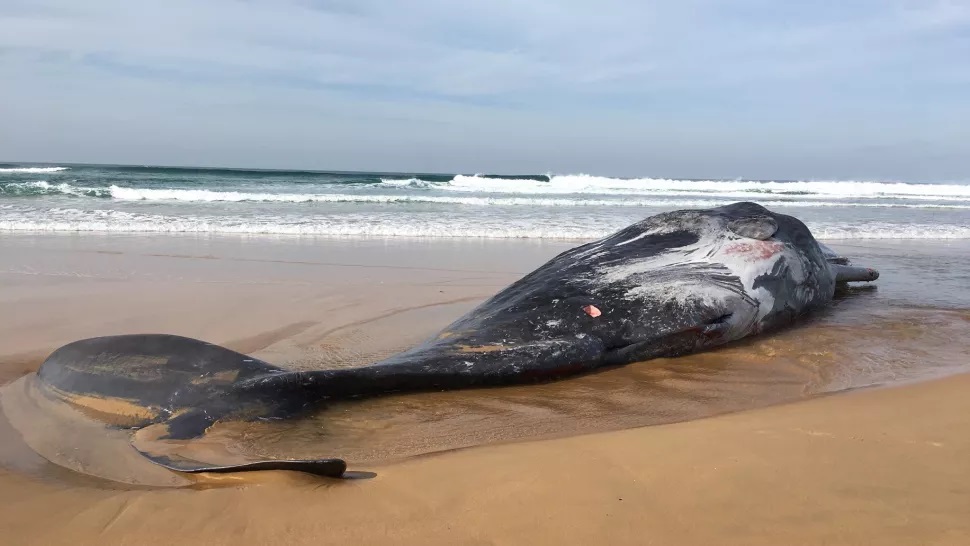It’s unknown how the whale actually died.

A huge dead whale rotting away on an island Down Under is attracting locals and even thieves, but the rancid smell of its decomposing corpse is keeping many of them at bay. One man who went to see the whale said its decaying blubber ruined his sneakers, and others have noted that they could smell the fetid stench even at a distance of 3 miles (5 kilometers), according to news sources.
Pathogens on the whale’s mouldering body are another reason to steer clear of the area, said the Department of Environment, Land, Water and Planning (DELWP) in Gippsland in Australia. In short, people should stay away from the beach, especially because hungry sharks could be swimming nearby, hoping to take a bite of the 52-foot-long (16 meters) sperm whale, the department said.
Whale carcasses often pose a problem when they wash ashore, as gases that build up inside their decaying bodies can lead to nasty explosions. Sometimes, local authorities will preemptively blow up dead whales, as they did in 1970 to a sperm whale in the now aptly named “Exploding Whale Memorial Park,” in Oregon, a decision they quickly came to regret.
“The humor of the situation suddenly gave way to a run for survival, as huge chunks of whale blubber fell everywhere,” Paul Linnman, a reporter who covered the explosion, said at the time. “Pieces of meat passed high over our heads, while others were falling at our feet.”
In this case, a sperm whale (Physeter macrocephalus) — the world’s largest toothed whale — washed ashore at Forrest Caves beach, a popular scenic destination on Phillip Island in southern Australia on March 6, DELWP Gippsland reported in a Facebook post.
The female whale’s final resting place on the beach is difficult to reach with a machine or vehicle large enough to move the animal, so “the whale will be left in place and not removed,” DELWP Gippsland wrote.
The department added that it’s illegal for people and their dogs to get within 980 feet (300 m) of a whale, even a dead one. It’s also illegal to take or possess dead whale parts, they said. But that hasn’t stopped determined thieves from using the cover of night to steal parts of the whale’s jaw, The Guardian reported.
Even in death, the whale is helping scientists learn about sperm whale behavior and biology. Researchers have taken tissue samples, DELWP reported. Meanwhile, “sucker marks” on the whale’s side indicate that the beast tussled with a giant squid, Mike Cleeland, an education officer at Bunurong Environment Centre in Inverloch, Australia, told Gippsland ABC Radio.
Just like another beached sperm whale he saw in the 1980s in Australia, this whale “had these sucker marks of up to about 10 centimeters [4 inches] diameter,” Cleeland said, as reported by the Sentinel-Times. “These sperm whales dive down to a kilometer [0.6 miles] or more in depth to feed on the giant squids, but if they come up to a squid and the squid tries to defend itself by wrapping itself around the sperm whale, they finish up with these sucker marks — and that was apparent on this one at Forrest Caves.”
However, it’s unknown what actually killed the whale. “There’s no obvious cause of death, so it may have simply reached the end of its natural life and washed in on its nearest beach here on Phillip Island,” Cleeland said.
Another dead whale, a 16-foot-long (5 m) humpback whale (Megaptera novaeangliae) was found offshore in Port Phillip Bay not too far from Phillip Island, and “plans are in progress to relocate the whale tomorrow,” DELWP Victoria wrote on Twitter on March 11.
